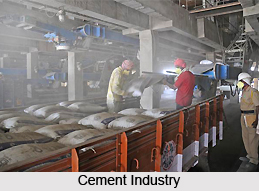 Cement industries in India are mainly located near limestone deposits as because this important building material is manufactured from clay and limestone. Bauxite, gypsum and iron oxide are also used considerably by the cement industries. Gypsum and coal are brought generally from distant places and cement is to be dispatched to the consuming centres that are sometimes located distant places. That is why generally the cement industries are located at close proximity to the railways. Interestingly, in some of the cement manufacturing plants, mud from fertilizer plants, sea shells and blast furnace slag are used instead of limestone. Some of the cement manufacturing plants in India those are located at Bhadravati in Karnataka, Chaibassa in Bihar uses sludge of fertilizers instead of limestone.
Cement industries in India are mainly located near limestone deposits as because this important building material is manufactured from clay and limestone. Bauxite, gypsum and iron oxide are also used considerably by the cement industries. Gypsum and coal are brought generally from distant places and cement is to be dispatched to the consuming centres that are sometimes located distant places. That is why generally the cement industries are located at close proximity to the railways. Interestingly, in some of the cement manufacturing plants, mud from fertilizer plants, sea shells and blast furnace slag are used instead of limestone. Some of the cement manufacturing plants in India those are located at Bhadravati in Karnataka, Chaibassa in Bihar uses sludge of fertilizers instead of limestone.
The key basic ingredient required for manufacturing cement that is limestone is available in almost all the states of India. The major cement plants in India are concentrated in and around north-eastern region of Karnataka and Tamil Nadu, south-eastern region of Madhya Pradesh, northern Andhra Pradesh, southern Bihar and eastern parts of Rajasthan. In regard to its key role in building and associated constructional activities, the cement industry is now considered as an infrastructural core industry. The inaugural cement factory was established in the year 1904 in Chennai. At present, there are more than around 115 large and 310 mini cement plants in India with an installed capacity of more than 110 million tonnes. In 1997-98 the total production was of the order of 83 million tonnes.
This article is a stub. You can enrich by adding more information to it. Send your Write Up to content@indianetzone.com















